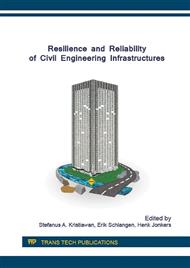p.89
p.94
p.100
p.106
p.113
p.119
p.126
p.132
p.140
Inclusion-to-Specimen Volume Ratio Influence on the Strength and Stiffness Behaviors of Concrete: An Experimental Study
Abstract:
The stress-strain response of the basic concrete making material, i.e. the mortar and aggregates, are well known. In general, the aggregate behaves linearly up till failure, possessing a very high ultimate compression strength and stiffness. The behavior of mortar is non-linear, even at low loading levels. The resulting composite material, the concrete, exhibits a less stiff response, in combination with degradation in strength. This study looked into the influence of the inclusion-to-specimen volume ratio of a 100x100x50 mm mortar specimen. Two inclusion configurations were considered, parallel and diagonal to the line of loading, while the ratio varied from zero to 0.66. It was shown that the inclusion-to-specimen volume ratio strongly influenced the strength, the stiffness, and failure mode. The strength behavior had a minimum and a maximum bifurcation point, while the stiffness response increased, as a function of an increase in the inclusion-to-specimen volume ratio. Visual observation of the cracking pattern revealed that the initial cracking was always situated at the interface between the aggregate and mortar in tension and propagated through the mortar matrix. It was also perceived that the crack propagation path of the very dense, diagonally arranged inclusions deviated from the columnar configuration observed from the parallel inclusion formation. These densely diagonally arranged aggregates also resulted in spalling in the lateral direction.
Info:
Periodical:
Pages:
113-118
Citation:
Online since:
July 2016
Permissions:
Share:
Citation:


